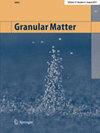Effect of inherent anisotropy of granular materials on the active and passive arching effect
Abstract
This paper analyzed the influence of the inherent anisotropy of sand on active and passive arching by simulating the trapdoor emplying the discrete element method (DEM). The inherent anisotropy is reflected by the bedding plane angle α of particles. The granular material constitutive responses are captured on representative volume elements (RVEs). A new modeling method is employed to prepare particle specimens, aiming to obtain a more uniform soil model. The results indicate that the discrete element method can simulate the influence of the inherent anisotropy of granular material on the evolution of soil arching. An asymmetric arching evolution phenomena is observed in the α other than 0° or 90° cases, which leads to obvious asymmetric deformation and stress distribution in the soil. As the filling height increases, this phenomenon becomes more and more obvious. From a microscopic perspective, the reorientation of the contact normal fabric caused by particle rotation is the main reason for the differences in soil arching evolution with different α. This study provides a theoretical basis for predicting ground deformation failure caused by underground engineering activities and changes in surrounding environmental conditions.
Graphical Abstract

 求助内容:
求助内容: 应助结果提醒方式:
应助结果提醒方式:


